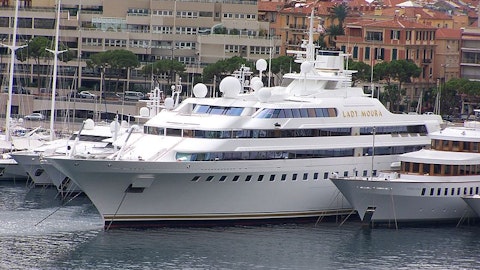William McGill: Yes, it’s not baking in any upswings or anything like that.
Brandon Rollé: Okay. Great. And just one last one. On your inventory, I think you had said you were about 20% below 2019 levels. Could you talk about where that inventory is on a dollar basis? And maybe where ASPs go from here from speaking with your OEMs about affordability and obviously, the customers looking for better pricing?
Michael McLamb: Yes, I can make a quick comment. Yes, units are well below on a same-store basis, dollars are going to be well above, which — there’s a couple of things driving that. One is the price increasing that every industry has seen in the last several years. The second thing is, is that we’re generally carrying larger and larger product even within a brand. The brands are building larger product. Customers want the larger product, et cetera. So plus like engine horsepower is much higher today than it was in 2019 and which drives costs up. So average unit selling price is up primarily because of mix within the industry. So hopefully, that answers your questions, Brandon.
Operator: Our next question is from David MacGregor with Longbow Research.
David MacGregor: A lot of my questions are asked so far, but let me ask you about the composition of the 350 basis points of gross margin decline. How much of that is a function of acquisitions and sort of other factors than say, the promotional programs you can discuss it so far?
Michael McLamb: Great question. It’s all going to be — and I’m doing this from memory right now. It’s all going to be really new and used boat margin-driven. And also probably a little bit of mixed business within that. When you drive positive same-store sales growth, like we did versus negative last year, the other higher-margin businesses shrink as a percentage of the revenue a little bit. It’s hard for them to keep up. And so your margin gets impacted by the mix shift. And that’s comparing it to the December quarter last year. And I don’t recall if there’s anything — I don’t think there was anything really unusual in the December quarter last year that would have drove margins higher other than product margins.
David MacGregor: Okay. And then secondly, Mike, just asking on inventories here. And obviously, things have changed. In the previous question, you talked about the change in the mix versus 2019 levels and engine horsepower is up and everything else that’s going on. So help us just understand as we think through inventory, what is the right level in terms of days or turns or however you want to talk about that?
Michael McLamb: I could comment. I don’t think the industry’s turns have ever been attractive until maybe the last couple of years. The industry historically used to be less than 2x turns. For ever and ever and ever, we were typically 2.5 to 3x turns. We really — in the industry right now is heavy in inventory. So a lot of people are back to historical turns. But getting back to where we used to be and above that is, I think, where the industry needs to be focused. And when we talk to our manufacturing partners, everybody really for the first time, was able to see the benefits of a faster-turning inventory industry last year, and all of our manufacturing partners are — they aim to keep the industry at a higher level, but they missed it because the industry ended last year a little too heavy.
So we’re in a correction period now. But I think when we get through this, we’re going to hopefully have an industry that has higher turns than it used to have, David. Long-winded way to say, it needs to improve from where it used to be.
David MacGregor: Yes. So 2.5 to 3x, that was the number I’m hearing from you in 2 years.
Michael McLamb: That’s where we would — I mean, honestly, that’s where we used to operate. We would love to operate better than that, but we need to get there, right?
Operator: Our next question is a follow-up from Mike Swartz with Truist Securities.
Michael Swartz: I just wanted to flip one last one in. With regards to the Williams Tenders business. I guess, one, is that now embedded in guidance? And then two, any way to frame how large or how material that business is to revenue or earnings?
Michael McLamb: Great question on that. I know we talked a little bit about on the call. It is not in our guidance. We don’t put acquisitions in our guidance until they actually close. And we’ll give everybody a little more color on it once it’s closed. It is accretive. It will be accretive in our fiscal year. The — anymore, Mike, with our size, there really isn’t anyone we can buy that’s really raw material from a revenue perspective, but it’s a great strategic company that has great leadership that ties in nicely to all of our businesses, but especially the superyacht business. So we’re happy and look forward to welcoming the Williams team to the MarineMax team.
Operator: And our next question is a follow-up from Joe Altobello with Raymond James.
Joseph Altobello: A quick question on IGY. What’s the contribution you’re expecting from that business within your EBITDA guide?
Michael McLamb: Well, it’s the contribution that we’re expecting from that business within the EBITDA guide, not a whole lot different than last year, Joe. I don’t — there isn’t — I mean, IGY’s growing. They’re working on different acquisitions. We haven’t — because we’re anniversarying that now, there’s going to be incremental improvements for what it would have been last year.
Joseph Altobello: Okay. So is it roughly 20% of the fiscal ’24 guide?



